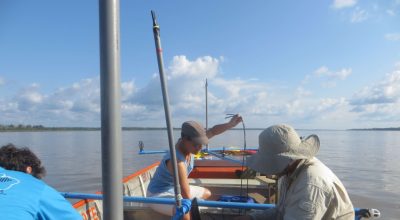聆听鲸目动物的声音

从著名的座头鲸变调曲到亚马逊粉红海豚的超声波声纳,栖息在海洋和河流中的哺乳动物使用声音的方式越来越令人惊叹。它们为什么使用声音?使用什么类型的声音?研究人员如何研究这些交流方式或定位方式,以及它们告诉我们关于我们海洋中的巨型表亲们的哪些信息?这都是海洋生物声学[1]试图回答的一些问题。海洋生物声学是一门结合生物学和物理学,以及计算机科学、生态学、数据处理和海洋学的学科。
1. 海洋中的声音
1.1. 声波在水中的重要性
水(特别是盐水)能导电。因此,电磁波(光波、无线电波等)在水中的传播情况相当糟糕。因此,海洋在深度达到几十米时就是一个极其黑暗的环境。尽管大多数海洋动物,尤其是哺乳动物,都拥有非常强大的眼睛,但它们不能像在陆地环境中那样有效地使用眼睛,至少不能用于远距离交流。另一方面,声音在水中传播得很好,比在空气中传播得更快,且几乎没有衰减。因此,许多海洋动物利用声音来收集或传递信息,就像人类通过设备和船只(潜艇、监视或地质勘探设备)所做的那样。
1.2. 海洋中的声音物理学

这则百科描述了声音的物理学(见:“声音的发射、传播和感知”)。声音被定义为超压的传播,通常以分贝为单位(即,一个对数单位,可以用来准确测量非常强和非常弱的值)。分贝的压力定义为P(dB)=20 log10(p/pref)。它需要一个参考压力pref。实用性考虑,它在空气和水是不同的。通常,如果空气中的参考声压压力为20µPa,则水中的声压为1µPa:因此,无法将水中的分贝量与空气中的进行比较。
水中的声速随水柱的深度而变化,从而产生了声学“波导”,使声音能够非常有效地长距离传播。图1来源于通过“声射线”模拟声音在水中的传播,表明来自同一点的声射线不是均匀得发散(可能被底部吸收),而是被引导到声速极小的水层中。
1.3. 水下录音

20世纪中叶,已有相对简单的仪器使我们能够研究水中的声音。目前,测量链通常由以下部分组成:
- 传感器,即水听器(水下麦克风),通常基于压电特性并配备软外壳,使其传声效果适应环境;
- 记录器,一种对信号进行数字化(可能经过滤波)并以数字形式存储的设备。数字化步骤涉及到采样率和分辨率,这些参数取决于所测声音的类型。
然后可以手动或通过自动程序处理或分析由此获得的信号(图2)。
1.4. 查看声音
为了分析声音,声学家使用了一种19世纪和20世纪发展的数学工具:傅里叶变换。通过处理,可以将信号从时域(压力随时间变化)变换到频域。频域允许根据声音的高频或低频分量分析声音,就像色谱允许评估光束的分量一样。通过做一些假设,我们可以将声音可视化为一种称为“时频”的表示形式,使我们能够将其频率内容视为时间的函数。这种基于高等数学理论的表示形式,如同看乐谱一般!
视频1.声音时频表示的图示。时间在X轴上,频率在Y轴上,颜色代表强度。我们可以看到,哨声类型的正弦波对应于集中在一个频率上的强度(这里是千赫兹的数量级),当声音被调制时,可能会发生变化。相反,抓拍的咔嚓声是一个短的声音(在时间上定位,这里在第6秒和第7秒),但其能量分布在一个较宽的频带上。
2. 水生哺乳动物发出的声音
2.1. 哪些是水生哺乳动物?

水生哺乳动物的定义是它在水中的时间:因此,北极熊目前被认为是海洋哺乳动物。然而,我们将主要关注最“特化”的水生哺乳动物,主要分为鲸目亚目,以及食肉目(包括海豹和海狮)和海牛目。它们通常生活在海洋中,有时生活在河流或湖泊中(图3),很少(食肉目)或没有(鲸目、海牛目)与陆地接触。有些种类生活在近岸区域并停留在较浅的深度,但很多种类可以在非常深的地方捕猎,有时甚至可以超过一千米。尽管有这种生活方式,且外观与鱼或鲨鱼很相似,但它们是以哺乳方式喂养幼崽并在空气中呼吸的哺乳动物[2]。
2.2. 产生声音的范例
水生哺乳动物发出的噪声种类繁多,并覆盖了部分远超人类听觉的声谱[3]。例如,最大的罗夸尔鲸(蓝鲸、长须鲸等)可以在几十秒内产生非常强烈的次声。这些声音的频率约为10赫兹,是动物界中最强的发声之一:它们在1米处达到190分贝(参考1µPa)(相当于大型商船在平均速度下的水平)。这些声音的强度使大型海洋哺乳动物能够在几十公里的距离内进行交流。相比之下,鼠海豚和河豚会发出短暂而重复的超声波,称为“咔哒声”,其频率可以达到几百kHz。
在这两个极端之间,我们也会发现海豚的哨声(例如宽吻海豚的哨声,还有虎鲸或领航鲸的哨声)呈现出很大的多样性,通常是人类可以感知的频率(几千Hz)。类似地,座头鲸的声乐曲目使它们成为水下生物声学的“明星”,从低沉的咆哮声到多种吱吱声或调制声,这些声音都非常显著,并且可以被人耳听到。
视频2. 宽吻海豚(Tursiops truncatus)发出的声音示例。我们将识别哨声、高音、调频声音(在5kHz和20kHz之间)、咔嗒声、短波和宽带(其中只有一部分在这里被记录,其余部分的频率对于记录设备来说过高),以及低频(约1kHz)的短吠声。
2.3. 某些特殊声音的生物学功能

这些不同的声音涉及到不同的生物学功能。例如,短促的“咔嗒声”是所有齿鲸(如海豚、鼠海豚、抹香鲸;或鲜为人知的喙鲸)的共同特征。它们在这些动物的定位中扮演着重要的角色,使这些动物在黑暗深处以动态追踪的方式追逐和捕捉猎物。这些咔嗒声与蝙蝠的定位功能相同:它们通过回传的回声让动物找到猎物或障碍物。此功能称为回声定位(参见“回声定位”)。
一些须鲸(也称真鲸或须鲸目)发出经过调制的声音,这些声音以高度结构化的序列重复出现。这一系列声音被称为“歌声”,类似于鸟类的歌声。这些歌声似乎是雄性的特权,因此可能具有与繁殖有关的功能,例如吸引雌性的注意或雄性之间的竞争。此外,这些歌曲有时是真正的方言,这使得区分同一物种的不同种群或氏族成为可能(参见焦点:蓝鲸歌声频率的下降)。
第三个例子是一些海豚,如宽吻海豚(Tursiops truncatus)的哨声,被证明能传达个体的特征[4]。在两个个体相遇的过程中,每个个体都重复他自身的“信号”,直至另一个个体重复相同信号回应,或许是标志着对对话者的识别(图4)。
3. 被动声学监测

水生哺乳动物广泛地使用声音,这对于研究它们来说非常有用。与“主动”声学(包括发出声音和研究反射波或透射波的行为)不同,被动声学的定义是仅在环境中记录声音,且不向被研究的环境中传输能量:因此,这是一种侵入性非常小的方法。
通过使用各种不同的技术,可获取不同的数据。技术成本有高有低,对研究对象的影响也存在差异。将一个装置直接放在受试动物身上(“标签”)无疑是最棘手的:多项研究表明,它可以改变动物的行为,在某些情况下甚至会伤害宿主[5]。但另一方面,它可以在个体层面获得非常多的结果,例如声音发出的深度和产生的能量,还可以验证特定声音来源于哪种生物。
船上使用的其他装置:
- 拖曳在船后的多个水听器组成的天线。这种技术对种群调查很有用,可以做成“声学横断面”,通常作为对视觉计数的补充。
- 在浮标上部或底部安装一个或多个固定传感器是最简单、侵入性最小的技术之一(图5)。
这些设备通常是“盲”操作的,因为没有视觉数据被添加到记录的声音中,但它们是安全、低价、耐用的技术,可以支撑局地、长期的种群调查,并精确研究特定发声的特征。
4. 生物声学的一些结果
水生哺乳动物的生物声学在其存在的五十年中,取得了一些有趣的进展,我们在此重点介绍几个例子。
4.1. 生理学

[来源:由帕特里斯在雷登伯格图片基础上绘制的图表[6]]((图6:BALEINE A FANONS 须鲸,MYSTICETE 须鲸,SAC LARYNGE 喉囊, MELON 额隆,AMPLIFICATION DES CLICS 咔嗒声放大,DAUPHIN 海豚,OONTOCETE海豚,LEVRES PHONIQUES声唇,PRODUCTION DES CLICS咔嗒声产生,REPLIS VOCAUX声音回荡, PRODUCTION DES VOCALISES调音制作)
鲸目动物对环境的生理适应性,有时会令它们与其他哺乳动物截然不同:最明显的例子是体型,蓝鲸是已知的体型最大的动物,无论是现存的还是化石的。
然而,研究这种体型的动物的生理学是一项挑战,因为对于许多物种来说,可研究的只有已经死亡很久的搁浅动物。特别是大型鲸目动物的发声方式仍然是个谜。然而,最近的研究结合了对搁浅动物的解剖、声音类型的分析、实验室重建的物理模型和计算机模拟,显示了产生声音的两个主要来源(图6)。
- 发声(口哨声、咆哮声等)是经空气通过“声带”(相当于声带,位于喉部)产生的,但空气并未排出,而是在在肺部和一个闭合回路“喉囊”之间循环[6]。
- 齿鲸产生“咔哒声”是发自一个特殊的器官(声唇)。然后,声音在额隆(海豚、抹香鲸等齿鲸头部的突出部分)被放大。额隆的作用是将声音放大,并将其聚焦到特定的方向。
对额隆的作用的认识为抹香鲸的研究提供了一个有趣的策略:采集并研究个体发出的“咔哒声”可以估计其大小!事实上,可以检测到额隆中的一系列回荡,回荡之间的时间可以评估动物头部的大小。由于该物种具有明显的性二型性(雄性平均比雌性大50%),因此我们可以知道该个体是成年雄性,还是雌性或年轻雄性(两者大小相同)[7]。
4.2. 行为
被动声学监测还可以在干扰最小的情况下深入了解个体的行为。例如,通过记录抹香鲸潜水时发出的咔哒声,可以重建其轨迹。下面的视频(视频3)显示了这只动物的活动,它达到了几百米的深度,并成功地搜索到了食物:据估计,咔嗒声节奏的加速对应着一次主动的捕猎(发现并追捕猎物),而沉默的时间间隔标志着猎物(通常是头足类动物)被捕获和消化的时刻。
视频3.视频链接:点击这里!显示从声学记录重建的抹香鲸轨迹的三维动画[8]。您可以听到录音并读取两次咔嗒声之间的时间。咔嗒声的加速和随后的沉寂被解释为成功狩猎的一个事件,包括捕获并吞食猎物(通常是鱿鱼)。
被动声学也可以用来理解鲸类的所谓“文化”行为:2013年发表的一项研究强调了座头鲸歌声在西南太平洋海盆从东向西的传播。值得注意的是,第二年新喀里多尼亚的雄性座头鲸开始向澳大利亚歌唱这个“流行”主题歌,同时海洋中其它群落开始关注这些歌曲。
4.3. 种群调查
统计一个物种的个体数量总是一项困难的工作;对于水生哺乳动物来说,这更是一个挑战,因为许多常用技术都无法使用:不可能找到痕迹或脚印,也不可能放置摄影陷阱……
除了少数例外(例如,在沿海具有稳定数量的种群),目视观察是很困难且低效的。事实上,鲸目动物很谨慎,与浩瀚的大海相比,它们数量很少,且大部分时间都在水下,无法看见。一旦天气条件恶化,就彻底地观察不到它们了。
因此,可以理解,生物声学在个体探测和计数中起着重要作用,因为它结合了以下几个优点:
- 监视可以昼夜进行;
- 对于某些物种(特别是大须鲸),仪器的范围可以扩展到几十公里;
- 该仪器可以以较低的成本长时间(几个月)运行。
尽管被动声学监测具有以上潜力,但这种技术在种群调查中的应用还是一门新兴技术,遇到了许多困难[9]。评估每个仪器的范围是建立种群密度统计模型的必要参数,但它取决于生物种类、发射信号的强度、环境条件、地形拓扑、仪器的响应等。目前无法根据发声信号来区分两个鲸目动物个体,所以很难知道同一个个体是否多次被监听到,或者某地点是否有多个个体经常出没。有些物种在某些时候声音很大,而在其它时候则完全沉默,无法被注意到。
不过,可以对不同的声学研究进行比较,从而确定某一物种在特定地点是否稳定,或其种群密度是否随季节或年份而变化。物种的声学行为也越来越为人所知。此外,现在已经有了复杂的声音传播模型。凭借这些工具,许多研究成功地克服了上述障碍。例如,离散性很强的齿鲸(据Cuvier 描述,最早的标本之一搁浅在马赛附近的 Côte Bleue)越来越多地由被动声学监测技术识别出来,而且通过随机网状浮标,能够感知其深度[10]。
4.4. 保护
上述种群密度计算是种群管理和物种保护的重要手段。综合所有技术(搁浅、视觉和声学调查等),已经表明南极蓝鲸(图7)的数量在二十世纪中叶经历了灾难性的下降,从分布在整个南部海域的约300000头到50年后记录的约400头[11]。在比该物种平均寿命还短的一段时间内,几乎每一千头中仅有一只逃脱了猎杀!目前的估计显示,在第一次暂停捕杀蓝鲸50多年后,种群数量恢复仍然十分缓慢(目前约有1000头)。
生物声学也可用于开发实时保护装置。例如在水下地质勘探时,会向海洋环境发送非常强的声脉冲以探测底土(巨大的超声波扫描)。这对环境,特别是海洋哺乳动物具有高度侵害性。在这类活动中,科学家们需要持续负责视觉和听觉警戒:如果在附近发现鲸目动物,声脉冲就需要中断发射。

另一个例子是[12]安装在美国波士顿湾的定点保护装置。一组水下传感器检测到大西洋露脊鲸的存在。大西洋露脊鲸是大型鲸类中受威胁最大的一种,被世界自然保护联盟(IUCN)列为极度濒危物种。当检测到露脊鲸存在时,该区域内的船只会接到警报,并且必须降低航速(噪音和碰撞是目前该物种面临的主要风险[13])。
5. 要记住的信息
- 所有的鲸目动物和许多鳍足类动物都利用水中良好的声音传播来进行交流、寻路、进食、识别危险等。
- 海洋哺乳动物生物声学的目标是了解水生哺乳动物发出的声音种类及其生物学功能。
- 除了可视化研究外,这门学科还用于识别濒危种群,以加强对它们的保护。
参考资料及说明
封面照片:一头雌性座头鲸在另一头鲸鱼关注的目光下从麦哲伦海峡的冷水中跃出。[来源:Cliché J. Patris]
[1] At the W. & Hastings M. (2008) Principles of marine bioacoustics. Springer
[2] Wilson D.E. & Mittermeier R.A. (2014) Handbook of the mammals of the world (4) Lynx edition.
[3] Richardson W. J. (1995) Marine Mammals and Noise. USA: Academic press
[4] Sayigh L., Esch C., Wells R. & Janik V. (2007) Facts about signature whistles of bottlenose dolphins, Tursiops truncates. Animal Behaviour, 74, 1631-1642
[5] Andrews R. et al (2019) Best practice guidelines for cetacean tagging. J. Cetacean Res. Manage. 20, 27-66
[6] Reidenberg J. S. (2017) Terrestrial, Semiaquatic, and Fully Aquatic Mammal Sound Production Mechanisms. Acoustics Today, 13 (2), 35-43.
[7] Rhinelander M. (2004) Measuring sperm whales from their clicks: Stability of interpulse intervals and validation that they indicate whale length. The Journal of the Acoustical Society of America, 115, 1826-31.
[8] Benard F. & Glotin G. (2010) Automatic indexing for content analysis of whale recordings and xml representation EURASIP Journal on advances in Signal Processing, 1-8
[9] Marques T. et al (2013) Estimating animal population density using passive acoustics. Biological Reviews 88, 287-309.
[10] Barlow J. et al. (2018) Diving behavior of Cuvier’s beaked whales inferred from three-dimensional acoustic localization and tracking using a nested array of drifting hydrophone recorders. The Journal of the Acoustical Society of America 144(4), 2030-2041
[11] Branch et al. (2007) Past and present distribution, densities and movements of blue whales Balaenoptera musculus in the Southern Hemisphere and northern Indian Ocean. Mammal Rev. 37(2), 116-175
[12] Spaulding E. et al. (2009) An autonomous, near-real-time buoy system for automatic detection of North Atlantic right whale calls. Proceedings of Meetings on Acoustics, 6,1-22 http://www.nrwbuoys.org
[13] NOAA fisheries (2019) Marine Mammal Stock Assessment Reports by Species/Stock: Right Whale, North Atlantic
环境百科全书由环境和能源百科全书协会出版 (www.a3e.fr),该协会与格勒诺布尔阿尔卑斯大学和格勒诺布尔INP有合同关系,并由法国科学院赞助。
引用这篇文章: PATRIS Julie (2024年3月11日), 聆听鲸目动物的声音, 环境百科全书,咨询于 2025年1月22日 [在线ISSN 2555-0950]网址: https://www.encyclopedie-environnement.org/zh/vivant-zh/listening-to-cetaceans/.
环境百科全书中的文章是根据知识共享BY-NC-SA许可条款提供的,该许可授权复制的条件是:引用来源,不作商业使用,共享相同的初始条件,并且在每次重复使用或分发时复制知识共享BY-NC-SA许可声明。







